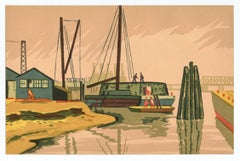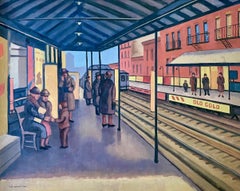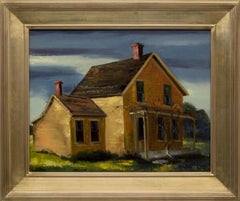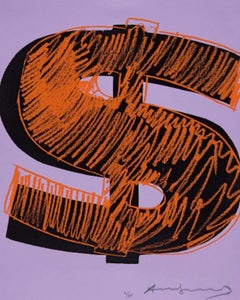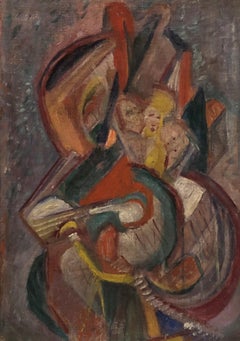Max Arthur Cohn
to
2
1
2
1
1
Overall Height
to
Overall Width
to
1
2
1
1
1
1
1
1
1
2
2
2
6,952
3,302
2,514
1,213
1
1
1
1
1
Artist: Max Arthur Cohn
"Harlem River" original silkscreen
By Max Arthur Cohn
Located in Henderson, NV
Medium: original silkscreen in eight colors. Printed in 1942 and published in New York by McGraw-Hill. Size: 6 x 9 inches (150 x 227 mm). Not signed.
Category
1940s Max Arthur Cohn
Materials
Screen
"NYC Subway" American Modernism Scene WPA Mid-Century Realism Cityscape Transit
By Max Arthur Cohn
Located in New York, NY
"NYC Subway" American Modernism Scene WPA Mid-Century Realism Cityscape Transit. 26 x 28 inches. Oil on canvas, c. 1940s. Signed lower left. Hand carved frame.
Max Arthur Cohn (1903 – 1988) Born in London, England, Cohn became an artist primarily known for scenes of New York City, rural views, and abstract figural compositions. His style has ranged from realism in the 1920s to 1940s to abstraction from the 1950s to 1990s, with some reintroduction in the later years of realism and re-working of earlier subject matter. His primary studio...
Category
1940s American Modern Max Arthur Cohn
Materials
Oil, Canvas
Related Items
East Santa Cruz (California), Farm House with Storm Clouds Landscape Painting
By Jon Blanchette
Located in Denver, CO
"East Santa Cruz (California)" is an oil on canvas board by Jon Blanchette (1908-1987) of a yellow farm house with dark gray storm clouds overhead. Presented in a custom frame, outer dimensions measure 21 ¾ x 25 ¾ x 1 ½ inches. Image size is 16 x 20 inches.
Painting is in very good vintage condition - please contact us for a detailed condition report.
Expedited and international shipping is available - please contact us for a quote.
About the Artist:
Jon Blanchette
Born England, 1908
Died California, 1987
Jon Blanchette was born in Somerset, England on March 29, 1908. He immigrated to Battle Creek, Michigan in 1918. Artistically inclined at age six, he later studied at the Pittsburgh Art...
Category
1950s American Modern Max Arthur Cohn
Materials
Oil, Board, Canvas
H 21.5 in W 25.5 in D 1.5 in
Dollar Sign (Unique) Andy Warhol
By Andy Warhol
Located in Palma, ES
EDITION 2/60 with 10 artist’s proofs)
Printed by Rupert Jasen Smith and published by the artist, New York.
See F. & S., II. 274-279 and IIa., 274-279.
Perhaps no other series reflect mass identity, luxury and wealth as prominently as Warhol’s Dollar Sign Series from 1982. The prints from this series are recognizable for repeatedly featuring the American dollar...
Category
1980s Pop Art Max Arthur Cohn
Materials
Screen
Adobe Church, New Mexico, 1940s Modernist Southwestern Landscape Oil Painting
By Paul Kauvar Smith
Located in Denver, CO
Vintage 1930s - 1940s oil painting of an adobe church in New Mexico with a brilliant blue sky and clouds (likely Rancho de Taos), circa 1940. Painted by Denver modernist, Paul K...
Category
1940s American Modern Max Arthur Cohn
Materials
Canvas, Oil
H 22 in W 26 in D 1.5 in
Night Life in the City - Figurative Cityscape
Located in Soquel, CA
Night Life in the City - Figurative Cityscape
Mid 1960s cityscape by an unknown artist. Oil on artists board.
Image, 16"H x 20"W
Category
1960s American Modern Max Arthur Cohn
Materials
Oil, Canvas, Illustration Board
Sling-Shots Lit #3
By Robert Rauschenberg
Located in Washington Depot,, CT
lithograph & screenprint on paper & assemblage with Sailcloth, Mylar, Wooden lightbox, fluorescent fixture, aluminum moveable window shade system and Plexiglas
Ed. 23/25
Category
1980s Abstract Expressionist Max Arthur Cohn
Materials
Mylar, Plexiglass, Wood, Paper, Sailcloth, Lights, Lithograph, Screen
Composition I
By Roy Lichtenstein
Located in Miami, FL
Screenprint on Lanaquarelle watercolor paper. Hand signed, numbered from the edition of 50 and dated in pencil. Published and printed by Gemini G.E.L., Los Angeles, with their blind...
Category
1990s Contemporary Max Arthur Cohn
Materials
Screen
Native American Figures at Taos Pueblo, New Mexico Southwestern Oil Painting
Located in Denver, CO
Original 20th century oil painting by Wolfgang Pogzeba (1936-1982) with Native American figures standing in bright blankets with adobe buildings in th...
Category
Mid-20th Century American Modern Max Arthur Cohn
Materials
Oil, Canvas
H 25.75 in W 29.5 in D 1.75 in
Six O'Clock
Located in Los Angeles, CA
Six O-Clock, c. 1942, oil on canvas, 30 x 20 inches, signed and titled several times verso of frame and stretcher (perhaps by another hand), marked “Rehn” several times on frame (for the Frank K. M. Rehn Galleries in New York City, who represented Craig at the time); Exhibited: 1) 18th Biennial Exhibition of Contemporary American Oil Paintings from March 21 to May 2, 1943 at The Corcoran Gallery of Art in Washington, D.C. #87, original price $450 (per catalog) (exhibition label verso), 2) Craig’s one-man show at the Frank K. M. Rehn Galleries, New York City, from October 26 to November 14, 1942, #10 (original price listed as $350); and 3) Exhibition of thirty paintings sponsored by the Harrisburg Art Association at the State Museum of Pennsylvania in Harrisburg in March, 1944 (concerning this exhibit, Penelope Redd of The Evening News (Harrisburg, Pennsylvania) wrote: “Other paintings that have overtones of superrealism inherent in the subjects include Tom Craig’s California nocturne, ‘Six O’Clock,’ two figures moving through the twilight . . . .” March 6, 1944, p. 13); another label verso from The Museum of Art of Toledo (Ohio): original frame: Provenance includes George Stern Gallery, Los Angeles, CA
About the Painting
Long before Chris Burden’s iconic installation outside of the Los Angeles County Museum of Art, Urban Light, another artist, Tom Craig, made Southern California streetlights the subject of one of his early 1940s paintings. Consisting of dozens of recycled streetlights from the 1920s and 1930s forming a classical colonnade at the museum’s entrance, Burden’s Urban Light has become a symbol of Los Angeles. For Burden, the streetlights represent what constitutes an advanced society, something “safe after dark and beautiful to behold.” It seems that Craig is playing on the same theme in Six O-Clock. Although we see two hunched figures trudging along the sidewalk at the end of a long day, the real stars of this painting are the streetlights which brighten the twilight and silhouette another iconic symbol of Los Angeles, the palm trees in the distance. Mountains in the background and the distant view of a suburban neighborhood join the streetlights and palm trees as classic subject matter for a California Scene painting, but Craig gives us a twist by depicting the scene not as a sun-drenched natural expanse. Rather, Craig uses thin layers of oil paint, mimicking the watercolor technique for which he is most famous, to show us the twinkling beauty of manmade light and the safety it affords. Although Southern California is a land of natural wonders, the interventions of humanity are already everywhere in Los Angeles and as one critic noted, the resulting painting has an air of “superrealism.”
About the Artist
Thomas Theodore Craig was a well-known fixture in the Southern California art scene. He was born in Upland California. Craig graduated with a degree in botany from Pomona College and studied painting at Pamona and the Chouinard Art School with Stanton MacDonald-Wright and Barse Miller among others. He became close friends with fellow artist Milford Zornes...
Category
1940s American Modern Max Arthur Cohn
Materials
Canvas, Oil
Simka Simkhovitch WPA Artist Oil Painting Gouache American Modernist Powerline
By Simka Simkhovitch
Located in Surfside, FL
Simka Simkhovitch (Russian/American 1893 - 1949)
This came with a small grouping from the artist's family, some were hand signed some were not.
These were studies for larger paintings.
Simka Simkhovitch (Симха Файбусович Симхович) (aka Simka Faibusovich Simkhovich) (Novozybkov, Russia May 21, 1885 O.S./June 2, 1885 N.S.—Greenwich, Connecticut February 25, 1949) was a Ukrainian-Russian Jewish artist and immigrant to the United States. He painted theater scenery in his early career and then had several showings in galleries in New York City. Winning Works Progress Administration (WPA) commissions in the 1930s, he completed murals for the post offices in Jackson, Mississippi and Beaufort, North Carolina. His works are in the permanent collections of the Dallas Museum of Art, the National Museum of American Art and the Whitney Museum of American Art. Born outside Kyiv (Petrograd Ukraine) into a Jewish family who owned a small department store. During a severe case of measles when he was seven, Simcha Simchovitch sketched the views outside his window and decided to become an artist, over his father's objections. Beginning in 1905, he studied at the Grekov Odessa Art School and upon completion of his studies in 1911 received a recommendation to be admitted to the Imperial Academy of Arts. Though he enrolled to begin classes in architecture, painting, and sculpture at the Imperial Academy, he was dropped from the school roster in December because of the quota on the number of Jewish students and drafted into the army. Simchovitch served as a private in the 175th Infantry Regiment Baturyn [ru] until his demobilization in 1912. Re-enrolling in the Imperial Academy, he audited classes.
Simka Simkhovitch exhibited paintings and sculptures in 1918 as part of an exhibition of Jewish artists and in 1919 placed 1st in the competition "The Great Russian Revolution" with a painting called "Russian Revolution" which was hung in the State Museum of Revolution. In 1922, Simkha Simkhovitch exhibited at the International Book Fair in Florence (Italian: Fiera Internazionale del Libro di Firenze). In 1924, Simkhovitch came to the United States to make illustrations for Soviet textbooks and decided to immigrate instead. Initially he supported himself by doing commercial art and a few portrait commissions. In 1927, he was hired to paint a screen for a scene in the play "The Command to Love" by Fritz Gottwald and Rudolph Lothar which was playing at the Longacre Theatre on Broadway. Art dealers began clamoring for the screen and Simkhovitch began a career as a screen painter for the theater. Catching the attention of the screenwriter, Ernest Pascal, he worked as an illustrator for Pascal, who then introduced him to gallery owner, Marie Sterner. Simkhovitch's works appeared at the Marie Sterner Gallery beginning with a 1927 exhibit and were repeated the following year. Simkhovitch had an exhibit in 1929 at Sterner's on circus paintings. In 1931, he held a showing of works at the Helen Hackett Gallery, in New York City and later that same year he was one of the featured artists of a special exhibit in San Francisco at the California Palace of the Legion of Honor in Lincoln Park. The exhibit was coordinated by Marie Sterner and included four watercolors, including one titled "Nudes". He is of the generation of Russian Soviet artists such as Isaac Pailes, Serge Charchoune, Marc Chagall, Chana Orloff, Isaac Ilyich Levitan, and Ossip Zadkine.
In 1936, Simkhovitch was selected to complete the mural for the WPA Post office project in Jackson, Mississippi. The mural was hung in the post office and courthouse in 1938 depicted a plantation theme. Painted on the wall behind the judge’s bench, “Pursuits of Life in Mississippi”, a depiction of black workers engaged in manual labor amid scenes of white professionals and socialites, was eventually covered over in later years during renovations due to its stereotypical African American imagery. Simka painted what he thought was typical of Jackson. His impression of pre-civil rights Mississippi was evidently Greek Revival column houses, weeping willow trees, working class families, and the oppression of African Americans. He painted African American men picking cotton, while a white man took account of the harvest and a white judge advised a white family, calling it Pursuits of Life in Mississippi.
Though clearly endorsed by the government and initially generally well-received, the mural soon raised concerns with locals as the climate toward racial segregation began to change. The main concern was whether depictions that show African Americans in subjugated societal roles should be featured in a courtroom. The following year, his painting "Holiday" won praise at an exhibition in Lincoln, Nebraska. In 1940, Simkhovitch's second WPA post office project was completed when four murals, "The Cape Lookout Lighthouse and the Orville W. Mail Boat", "The Wreck of the Crissie Wright", "Sand Ponies" and "Canada Geese" were installed in Beaufort, North Carolina. The works were commissioned in 1938 and did not generate the controversy that the Jackson mural had. The main mural is "The Wreck of the Crissie Wright" and depicts a shipwreck which had occurred in Beaufort in 1866. "The Cape Lookout Lighthouse and the Orville W. Mail Boat" depicted the lighthouse built in 1859 and the mail boat that was running mail during the time which Simkhovitch was there. The boat ran mail for the area until 1957. "Sand Ponies" shows the wild horses common to the North Carolina barrier islands and "Canada Geese" showed the importance of hunting and fishing in the area. All four murals were restored in the 1990s by Elisabeth Speight, daughter of two other WPA muralists, Francis Speight...
Category
1930s American Modern Max Arthur Cohn
Materials
Gouache, Oil, Board
Simka Simkhovitch WPA Artist Oil Painting American Modernist Landscape Pond Tree
By Simka Simkhovitch
Located in Surfside, FL
Simka Simkhovitch (Russian/American 1893 - 1949)
This came with a small grouping from the artist's family, some were hand signed some were not.
Thes...
Category
1930s American Modern Max Arthur Cohn
Materials
Oil, Board
Blue Face from the Brushstroke Figures Series
By Roy Lichtenstein
Located in Miami, FL
Lithograph, waxtype woodcut and screenprint on 638-g/m cold-pressed Saunders Waterford Paper. From the "Brushstroke Figures" series, 1989. Hand signed rf Lichtenstein, dated ('89) a...
Category
1980s Contemporary Max Arthur Cohn
Materials
Lithograph, Screen, Woodcut
Free Shipping
H 53.7 in W 38.9 in
"Wolfbat Leopard Snake" 6 Color enamel silkscreen
By Dennis McNett
Located in Philadelphia, PA
"Wolfbat Leopard Snake" is a 6 color enamel ink silkscreen print measuring 29in x 21.5in, and is part of an edition of 25. The ink splatters in the background are part of the design...
Category
21st Century and Contemporary Contemporary Max Arthur Cohn
Materials
Enamel
Previously Available Items
Stuyvesant Park NYC American Scene Mid 20th Century WPA Realism Cityscape Modern
By Max Arthur Cohn
Located in New York, NY
Stuyvesant Park NYC American Scene Mid 20th Century WPA Realism Cityscape Modern. 25 x 20 inches. Oil on canvas, c. 1930s. Signed lower right.
Max Arthur Cohn (1903 – 1988) was bor...
Category
1930s American Modern Max Arthur Cohn
Materials
Canvas, Oil
"Composition, " Max Arthur Cohn, Abstract Figurative WPA Music Dance
By Max Arthur Cohn
Located in New York, NY
Max Arthur Cohn (1903 - 1998)
Composition, 1938
Oil on canvasboard
14 x 10 inches
Signed, titled, and dated on the reverse
Provenance:
Private Collection, Alpine, New Jersey
Private...
Category
1930s Abstract Max Arthur Cohn
Materials
Oil, Board
Night Scene, American Modern Silkscreen by Max Arthur Cohn 1944
By Max Arthur Cohn
Located in Long Island City, NY
Max Arthur Cohn was a British artist who emigrated to the US and studied at the Art Student's League in the 1920's with John Sloan. This is an iconic American Modern image of a dark...
Category
1940s American Modern Max Arthur Cohn
Materials
Screen
Max Arthur Cohn art for sale on 1stDibs.
Find a wide variety of authentic Max Arthur Cohn available for sale on 1stDibs. You can also browse by medium to find art by Max Arthur Cohn in canvas, fabric, oil paint and more. Much of the original work by this artist or collective was created during the 1940s and is mostly associated with the modern style. Not every interior allows for large Max Arthur Cohn, so small editions measuring 9 inches across are available. Customers who are interested in this artist might also find the work of Cecil Crosley Bell, Byron Browne, and Clarence Holbrook Carter. Max Arthur Cohn prices can differ depending upon medium, time period and other attributes. On 1stDibs, the price for these items starts at $200 and tops out at $18,000, while the average work can sell for $9,100.
